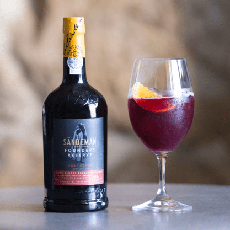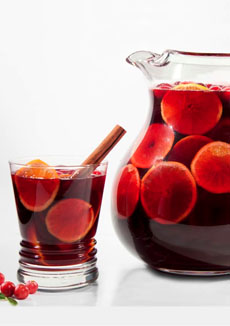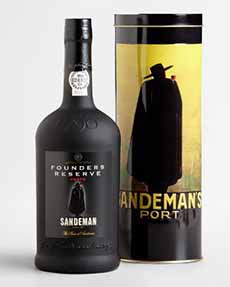Sangria With Port, The History Of Port & Types Of Port
|
|
Seven Christmases past, we made a Christmas Sangria with Sandeman Port. It included cinnamon schnapps and clementine soda, and was a big hit. Here’s the recipe for Sandeman Sangria #1. It has been the official warm-up drink of our Christmas festivities. But wait: There’s a new Christmas Sangria from Sandeman, and it’s a much simpler recipe. Sandeman makes several expressions of Port: the classic ruby, tawny and white Ports; aged tawny; reserve wines; and vintage wines (see the different types of port below. The well-known icon, called Don [Mr.] Sandeman, features a man dressed in a Portuguese student’s cape and a wide Spanish-style hat (photo #4). International Port Wine Day is January 26th. Raise your glass! > Below: The different types of Port. Ingredients Per Cocktail 1. FILL a tulip glass (or other wine glass) with ice. Add the ingredients and stir well with a bar spoon. 2. GARNISH and serve. Port is a Portuguese fortified wine, a red wine made from a variety of Portuguese grapes*then blended with distilled grape spirits. It is made in the Douro Valley in the northern provinces of Portugal. Only wine here can legally be called Port. (Wine Trivia: The Douro region is the third-oldest protected wine region in the world, after the Chianti region of Italy, established in 1716, and the Tokaj-Hegyalja region in Hungary established in 1730. It’s Port in English, Porto in Portuguese, and is sometimes written as Oporto, after Porto, the largest city in the region and the second-largest city in Portugal (Oporto means “the Porto”). Porto, located along the Douro River estuary in northern Portugal, was an outpost of the Roman Empire. Port wine has been produced since then. It is typically a sweet, red wine, often served as a dessert wine, though it also comes in dry, semi-dry, and white varieties Port is made in several expressions: Crusted, Colheita, Late Bottled Vintage (LBV), Ruby, Single Quinta, Tawny, Vintage, Vintage Character, and White. Here’s an explanation of each type of Port. See more detail on these types of Ports below. Grapes have been grown in Portugal since antiquity; ancient writings show that the inhabitants of northern Portugal were already drinking wine 2,000 ago. The Romans arrived in Portugal in the second century B.C.E. and remained for the next five hundred years. They grew grapes and made wine on the banks of the Douro River, where Port is produced today. After the establishment of the Kingdom of Portugal in 1143, wine from the Douro Valley become an important export. But it was a different wine. By the second half of the 15th century, a significant amount of Portuguese wine was being exported to England. The first wines known as Port were exported in the latter 17th century, following the Anglo-Portuguese commercial treaty of 1654. English wine merchants settled in Portugal to oversee the trade. The fortified wine we know today was first created to preserve the wine during the long journey from the Douro Valley to England. It began to be fortified with the addition of brandy prior to bottling the aged red wine. Today, the process of fortifying Port is different: The wine is fortified during fermentation and not after aging. |
|
|
THE EXPRESSIONS (TYPES) OF PORT Expressions is an industry name for the different styles, types, or varieties produced by a particular house [brand]. Colheita Port: A single-vintage tawny port is aged for at least seven years. The vintage year is on the bottle, instead of a category of age (10 years, 20 years, etc.). It differs from Vintage Port, which spends only about 18 months in barrels after vinification and will continue to mature in the bottle. A Colheita may have spent 20 or more years in wooden barrels before being bottled and sold. White Colheitas have also been produced. Crusted Port: Usually a blend of several vintages to achieve specific characteristics, Crusted Port is bottled unfiltered and sealed with a traditional cork. Like Vintage Port, it needs to be decanted before drinking. Garrafeira Port: Unusual and rare, vintage-dated Garrafeira is maturation for three to six years in wood to oxidize it, with further maturation in large glass demijohns, for at least eight years in glass. Late Bottled Vintage (LBV) Port: Originally a wine that was destined for bottling as a vintage port, LBV was left in the barrel for longer than had been planned, due to lack of demand. Over time it evolved into two distinct styles of wine, both of them bottled between four and six years after the vintage. However, one style is fined and filtered before bottling, while the other is not. Reserve Port: This is reserve Ruby Port, a premium ruby approved by the tasting panel of the IVDP, the industry association. Rosé Port: A new expression, first released in 2008 by Poças and by Croft, part of the Taylor Fladgate Partnership. It is technically a Ruby Port but is fermented in a manner similar to rosé wine. It receives limited exposure to the grape skins, thus creating the rosé color. Single Quinta Vintage Port: These Vintage Ports originate from a single estate, unlike most Vintage Ports which can be sourced from a number of quintas. These are only produced in certain years when the regular Vintage Port of the house is not declared. Tawny Port: These red grape wines are aged in wooden barrels exposing them to gradual oxidation and evaporation. They thus mellow to a golden-brown color, and the exposure to oxygen imparts nutty flavors to the wine. They can be sweet or medium-dry; they are typically served as a dessert wine but can be served with the main course as well. Vintage Port: Made entirely from the grapes of a declared vintage year, Vintage is by far the most renowned type of Port, the “top of the line.” But from a volume and revenue standpoint, Vintage Port accounts for only about 2%f overall port production. As with Champagne, not every year has grapes ripe enough and balanced enough to declare a vintage. The finest vintages can continue to gain complexity for many decades after botting; some 19th-century bottles are still in perfect condition for consumption. White Port: Made from white grapes (Malvasia Fina, Donzelinho, Gouveio, Codega, and Rabigato, the white port can be made in a wide variety of styles, from dry to very sweet. Young White Ports make an excellent base for a cocktail; sweet White Port and tonic water is a common drink in the Porto region. Aged whites are best served chilled on their own. *The six most widely used grapes for red Port wine are Touriga Franca, Tinta Roriz, Tinta Barroca, Touriga Nacional, Tinta Cão and Tinta Amarela. Here are the other grapes that can be used. CHECK OUT WHAT’S HAPPENING ON OUR HOME PAGE, THENIBBLE.COM.
|
||






